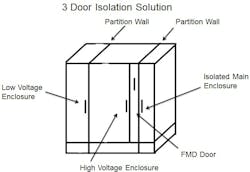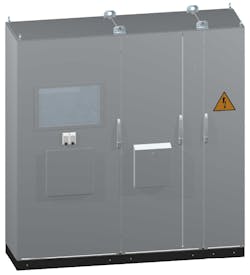Understanding and Mitigating the Potential for Arc-Flash Injuries
For systems designers, and facility and maintenance engineers, no responsibility is more critical than that of protecting personnel from injury or death in the workplace. Arc flash is one of the most potentially lethal workplace hazards. This article offers important background on what causes arc flashes, the safety standards that govern arc-flash protection, and how investing in proper electronics enclosure designs and upgrades can prevent these injuries.
Essentially, an arc flash is the explosive release of energy that occurs due to a phase-to-phase or phase-to-ground arc fault (in other words, an electrical short circuit). The dangers an arc flash poses are very real to those who work with and service equipment with electrical power. An arc blast is caused by the expansion of metal as it vaporizes, causing extreme heating of the air (up to 35,000°F) by arc energy. This blast can create a shock wave capable of knocking personnel off of their feet, intense light flashes that can lead to blindness, noise loud enough to cause hearing damage, severe burns, or even death. An arc flash can be the result of unsafe work procedures, accidental contact such as a dropped tool or inadvertent touch, or the consequence of more systemic problems like corrosion of components and connections, insulation failure, conductive dust buildup, animal contact, or other factors.
Safety Regulations
Several industry and governmental standards have been developed to ensure the safety of those who must work near electrical equipment with the potential to produce an arc flash:
- Occupational Safety and Health Administration (OSHA) Standards 29-CFR 1910-S, number 1910.333: “Selection and Use of Work Practices.”
- Institute of Electrical and Electronics Engineers 1584-2002: “IEEE Guide to Performing Arc Flash Hazard Calculations.” This guide provides techniques for designers and facility operators to apply in determining the arc-flash hazard distance and the incident energy to which employees could be exposed during their work on or near electrical equipment.
- National Fire Protection Association (NFPA) 70E-2015: “Standard for Electrical Safety Requirements for Employee Workplaces.” The intent of NFPA 70E regarding arc flash is to provide guidelines that will limit injury to second-degree burns, including:
A flash hazard analysis shall be done in order to protect personnel from the possibility of being injured by an arc flash (Flash Protection Boundary and Limits of Approach).
Only qualified personnel who possess the skills, knowledge and safety training to recognize and avoid hazards shall be permitted to work on electrical conductors or circuit parts.
Personal Protective Equipment requirements designed and constructed for the specific part of the body to be protected and for the work to be performed. NFPA 70E, Annex H and Table H.3 (a and b).
For safety, whenever it’s essential to open an equipment enclosure, the power should be completely de-energized by authorized and trained personnel wearing the appropriate level of personal protective equipment (PPE) for the application. This is done to ensure safe work conditions by following an approved process of identifying all power sources, interrupting and disconnecting the power source, verifying that the circuit is open, locking and tagging out the circuit so that it cannot be re-energized while servicing, final testing and grounding as required, ensuring the absence of power.
Common design and retrofit approaches to limiting exposure to arc flash include using components installed outside the enclosure to permit qualified personnel with the required PPE to service equipment inside without opening the enclosure door. Components like interface flaps, window kits, and interface extensions can often permit data retrieval, equipment monitoring, or routine maintenance from outside. Data pockets on the enclosure’s exterior simplify storing pertinent information securely right where it’s needed. Fold-down shelves make it convenient to use laptops and other equipment during service without the need to open the enclosure. Although these solutions are suitable for routine maintenance, they can’t address situations when components can only be accessed from inside the enclosure.
When opening an enclosure can’t be avoided, the ideal solution is to isolate all line-side power externally to the enclosure. The most advanced power isolation enclosure designs (Figs. 2 and 3) allow moving the line-side power outside the disconnect enclosure and partitioning it off, removing the potential for accidental contact with the in-line power when the disconnect enclosure is put in a safe power-off position and locked and tagged out. Expanding on this modular approach, users can then install all low-voltage components (<50 V) in a separate partitioned-off enclosure. This allows a qualified person wearing minimal required PPE and following the appropriate safe work practices to perform visual inspections and tasks such as diagnosis/testing, troubleshooting, and voltage measurement with the door open, when it is determined there’s no increased exposure to electrical burns or explosion due to electric arcs, even when the main enclosure is energized. This modular design approach allows for future system expansion simply by adding an enclosure and appropriate door-to-door interlocking system for safe operation.
Protecting workers and equipment from arc flash damage is a critical part of any facility manager’s responsibilities. To learn more about arc flash and enclosure solutions that can minimize its dangers, request a free copy of Rittal’s white paper—Arc Flash and How to Prevent It




